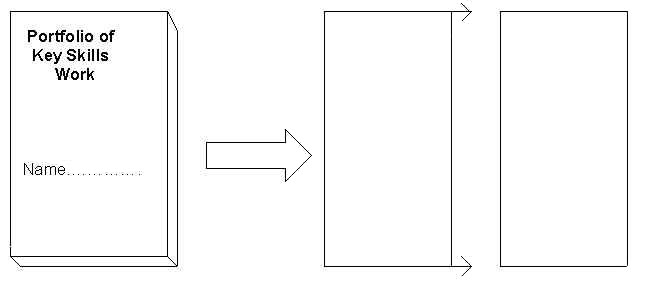|
|||||||||||||||

Key Skills open doors ... for life, learning and employment
Example 1: Building up a portfolio
Employers require evidence that key skills have been acquired or are possessed by the student, trainee or person seeking work. This requirement often creates problems for the individual job-seeker - 'How is evidence accumulated and where is it to be kept?' The answer is to be found in a 'portfolio'.
![]() (a) The conceptual context
(a) The conceptual context
![]() Philosophy and rationale
Philosophy and rationale
The concept of a 'portfolio' is rooted in the approach adopted
in Wales and England to the delivery of key skills, that is, through
a student or trainee's main courses of study or training programme.
Since this takes place over a period of time there is a need to
'store' evidence in some way (usually within a folder), and build
it up into a coherent record. This can then be presented to an
employer, when needed. Students/trainees need to be given guidance
in the best way to approach the compilation of a portfolio. This
is especially important in terms of the older unemployed person.
In this case, the lack of relevant or up-to-date qualifications
often act as a barrier to progress; training in portfolio building
allows the individual to highlight her/his strengths rather than
weaknesses.
![]() Objectives
Objectives
A portfolio is designed to allow the individual to:
(a) keep a record of a range of evidence.
(b) accumulate only positive evidence of achievement.
(c) amend material, as necessary.
(d) use it as a starting point at interviews, etc.
![]() Target Group
Target Group
Can be developed by all students/trainers/individual job seekers.
![]() Players involved
Players involved
(a) The individual undergoing key skills training.
(b) The trainer.
(c) Potential user - employer.
The value of the portfolio is enhanced if all the players in an area, e.g. the TEP, adopt the same rationale and requirements. This will result in a portfolio that virtually becomes a 'passport' for the student/trainee. However, in order to be effective, the players need to be appropriately trained in the aims and rationale of portfolio construction and use.
![]() (b) Design of the Portfolio
(b) Design of the Portfolio
Trainers and future employers get an idea of a person's key skills' achievements from the 'portfolio' or record. The portfolio should tell other people:
![]() what
key skills have been acquired;
what
key skills have been acquired;
![]() at what
level; and
at what
level; and
![]() about
the nature of the evidence which proves they have been achieved.
about
the nature of the evidence which proves they have been achieved.
In other words (being addressed to the student/trainee/job seeker), it shows how the individual has moved through the following process:
|
1.
How you have acquired and practised the various key skills
2.
Demonstration/production of evidence
3.
Assessment of evidence
4.
Building a portfolio of assessed evidence
5.
Recording and logging location of the LOGBOOK evidence |
What exactly are the portfolio and logbook like? The diagrams below illustrate a typical example of each.
A
PORTFOLIO:
Each of the pages making up the 'book' contain evidence of the
student/ trainee/ job seeker's achievement in the key skills

SUPPORTED BY -
A
LOGBOOK:
This explains the nature of the evidence, where it is to be 'found'
(in the portfolio) and when it was produced. Each separate page
is devoted to a key skill.

![]() (c) Evaluation and feedback
(c) Evaluation and feedback
The use of portfolios has been evaluated during a major national key skills development programme and found to be an effective method of recording key skills achievement for most trainees and job seekers. Conversely, lack of a portfolio seriously hampered an individual's progress and her/his ability to use key skills achievement in job seeking.
|
WJEC NREC |
||
| Produced
by: UK: WJEC, NREC Germany: BILSE (Institute for Education and Research), Economic Development Company Greece: PRISMA Sweden: Swedish University Agricultural Department, Hogsby Municipality, Sweden |
||
 |
Project carried out with the support of the European Community within the framework of the Leonardo da Vinci Programme. This document does not necessarily represent the Commission's official position. |
|